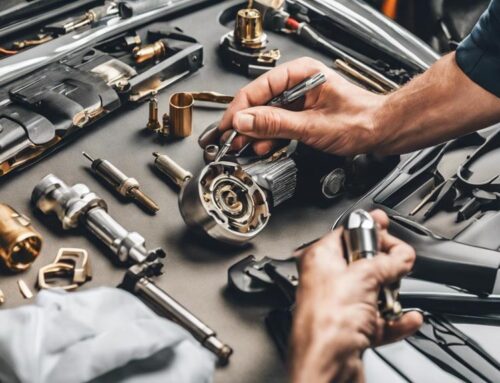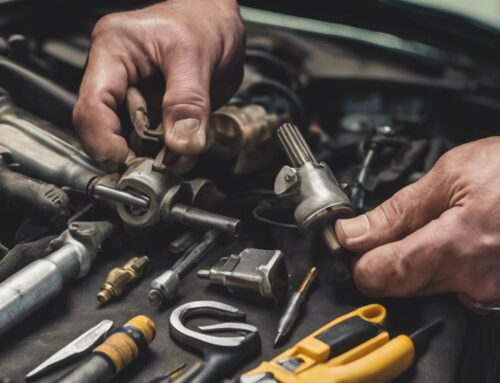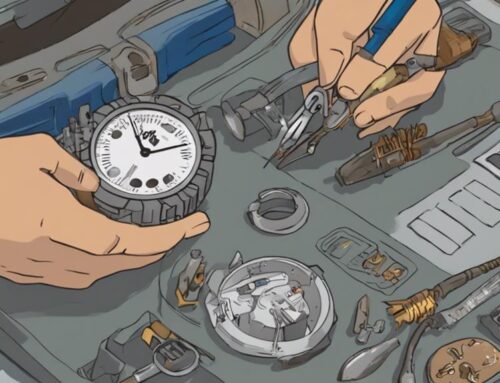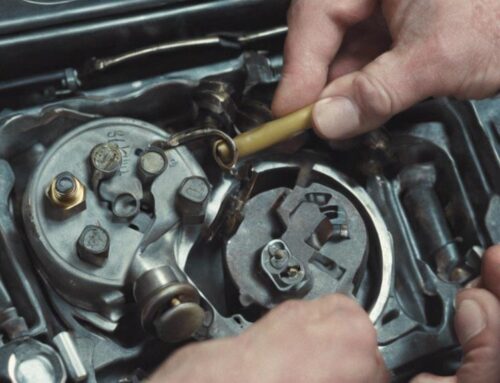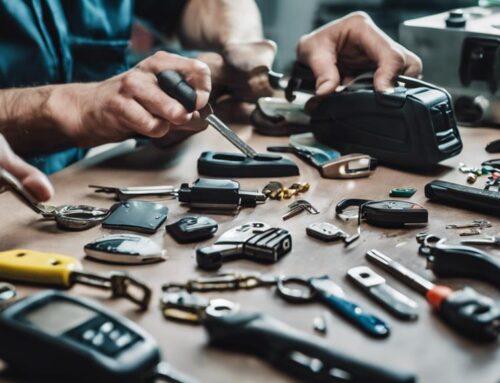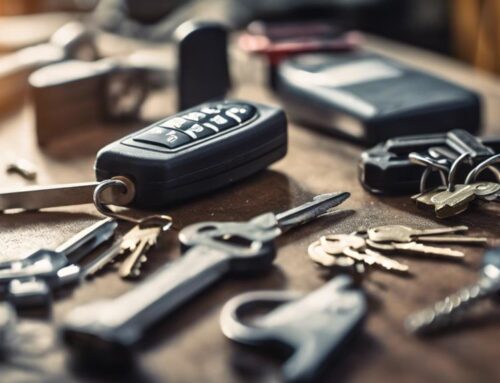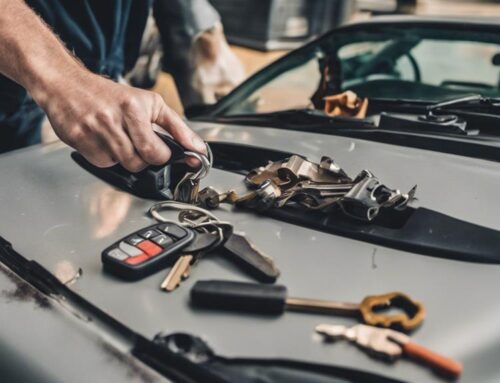When your key fob suddenly goes silent, it feels like a storm clouds your day. First, you'll want to check the battery, but if that doesn't solve the problem, you'll need a strategic plan. Whether it's lost or stolen, the next steps can be essential for your vehicle's security. You might wonder how to navigate the maze of replacements and precautions. What if the solution isn't as complicated as you think?
Key Takeaways
- Check the battery of your key fob for corrosion or wear; replace it if necessary to restore functionality.
- If lost or stolen, report it to the police and inform your insurance provider to initiate claims.
- Reprogram or deactivate the lost fob to prevent unauthorized access to your vehicle.
- Consider using a spare fob; ensure it's clean and fully charged before testing its functionality.
- Consult your vehicle manual or manufacturer for specific instructions on replacing or reprogramming the key fob.
Check the Battery
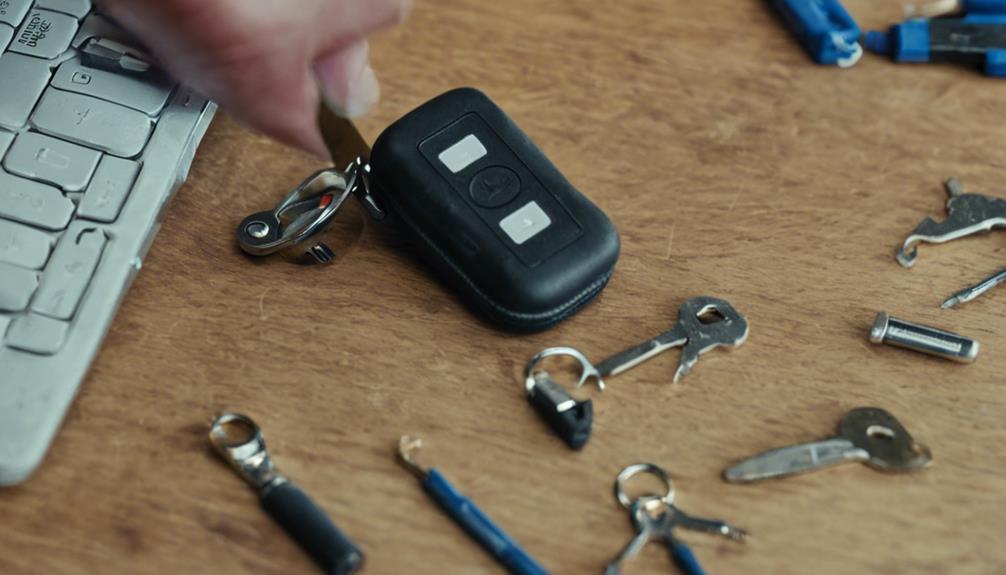
When your key fob suddenly stops working, the first thing you should do is check the battery. A dead battery is often the culprit, so pop open the fob and inspect it. If the battery looks corroded or worn out, replace it. Standard batteries are easy to find, but consider battery alternatives like rechargeable options for long-term key fob maintenance. They can save you money and reduce waste. Don't forget to test the fob after replacement; you want to verify it's functioning before assuming other issues. Keeping spare batteries on hand is a smart move—empower yourself by staying prepared. Regularly checking the battery can prevent annoying breakdowns, giving you confidence in your vehicle's access.
Inspect for Damage
Now that you've checked the battery, it's time to inspect your key fob for any physical damage. Look closely for signs of wear, such as cracks or loose buttons, which could affect its functionality. A thorough inspection can help you identify issues before they become bigger problems.
Physical Inspection Process
A thorough inspection of your key fob is essential to identify any visible damage that might be causing it to malfunction. Start by examining the exterior for cracks, dents, or worn-out buttons—these could hinder functionality. Pay attention to the seams; if they're loose or misaligned, it could indicate internal damage. During your inspection, you should also look for signs of water exposure or corrosion, which can severely impact performance. Implementing effective key fob maintenance will prolong its life. Utilize these troubleshooting techniques to guarantee all components are intact and functioning, as outlined in Unlocking the Process: Key Fob Programming Explained. If you discover any issues, addressing them promptly can save you from costly replacements down the line. Keep your key fob in top shape and regain control over your vehicle.
Check Battery Condition
After inspecting the physical condition of your key fob, the next step is to check the battery. Open the fob carefully to avoid damaging any internal components. Look for any signs of corrosion or leakage around the battery. If you see any, it's a clear indicator that it's time for a replacement. For key fob troubleshooting, you should also verify the battery is seated correctly; a loose battery can prevent your fob from functioning. When replacing the battery, make sure to note the type and specifications, as using the wrong battery could lead to further issues. Follow these battery replacement tips closely, and you'll be back in control in no time!
Look for Wear Signs
Inspecting your key fob for signs of wear is essential to guaranteeing it functions properly. Regular key fob maintenance can prevent common problems that might leave you locked out of your vehicle. Start by checking for cracks or dents on the casing. If the buttons feel sticky or unresponsive, dirt or debris may have infiltrated the device. Look for signs of corrosion, particularly around the battery compartment, which can impede performance. Additionally, inspect the key ring attachment; a loose connection can lead to accidental drops. By identifying these wear signs early, you can address issues before they escalate, keeping your key fob in prime condition and maintaining your access to your vehicle with confidence. Locksmiths are skilled in handling key fobs for a wide range of vehicles, including luxury and high-security models, offering programming and replacement services to guarantee you have seamless access to your car Can Locksmiths Handle Key Fobs for Any Vehicle.
Try a Spare Fob
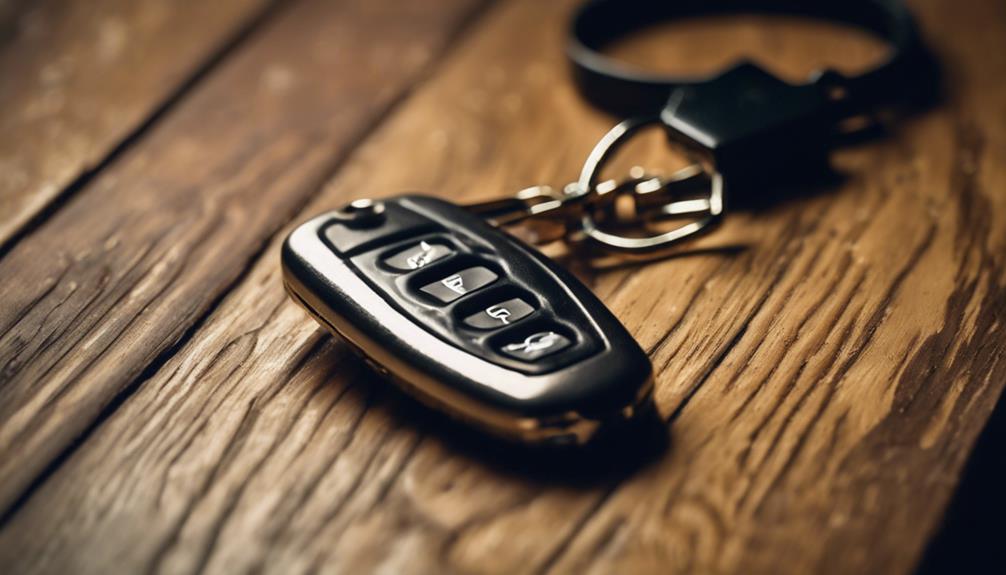
If your key fob suddenly stops working, trying a spare fob can be a quick and effective solution. This alternative entry method allows you to regain access without delay. Here's what you should do:
- Locate your spare fob: Check your home or car for a backup fob. You might have one tucked away for emergencies. If you're unsure about the condition of your spare fob, consider getting it checked by reliable locksmith services for key fob needs anytime.
- Conduct key fob maintenance: Make certain the spare fob's battery is charged and free from dirt or debris. A little upkeep can go a long way.
- Test the spare fob: Once you've located and maintained it, try using the spare fob to access your vehicle. If it works, you've sidestepped a potential headache!
Reprogram the Key Fob
Sometimes, even a spare key fob might need a little help to function properly. Reprogramming your key fob can restore its power, ensuring you regain full control over your vehicle. Different key fob types require specific programming techniques, but the process is often straightforward.
| Key Fob Type | Programming Technique |
|---|---|
| Standard Key Fob | Turn ignition on/off five times |
| Proximity Key Fob | Press the lock button five times |
| Smart Key | Insert key, press start button without brake |
| Keyless Entry Fob | Lock/unlock using the driver's door |
Don't let a malfunctioning key fob hold you back. Understanding these techniques empowers you, giving you the confidence to tackle the issue head-on.
Contact Your Vehicle Manufacturer

When your key fob stops functioning despite your efforts to reprogram it, reaching out to your vehicle manufacturer is a smart move. They have the expertise and resources to help you navigate key fob technology issues that could compromise your vehicle security. Here's what to do:
- Gather your vehicle information: Have your VIN and model details ready for quicker assistance.
- Inquire about replacement options: Ask about replacement key fobs, as they may require specific programming for your vehicle. If you're unsure about the process, locksmiths can also handle keyless entry remotes, as discussed in Can Locksmiths Handle Keyless Entry Remotes.
- Understand warranty coverage: Check if your key fob or related services are covered under warranty, saving you money.
Report a Stolen Fob
Reporting a stolen key fob is essential to protecting your vehicle from potential theft. First, contact your local police department to file a report. This documentation can support your insurance claim, ensuring you're covered against losses. Next, inform your insurance provider about the situation. They'll guide you through the claims process and may require the police report. If you're unsure how to proceed, locksmiths specializing in keyless entry programming are available 24/7 for assistance, ensuring your vehicle's security around the clock.
Additionally, consider disabling key fob features that might allow unauthorized access to your car. Many modern vehicles have options to reprogram or deactivate lost key fobs, enhancing your security. Taking these steps not only safeguards your vehicle but also empowers you to take control of the situation. Don't wait—act swiftly to mitigate any risks associated with a stolen key fob.
Verify the Fob's Compatibility
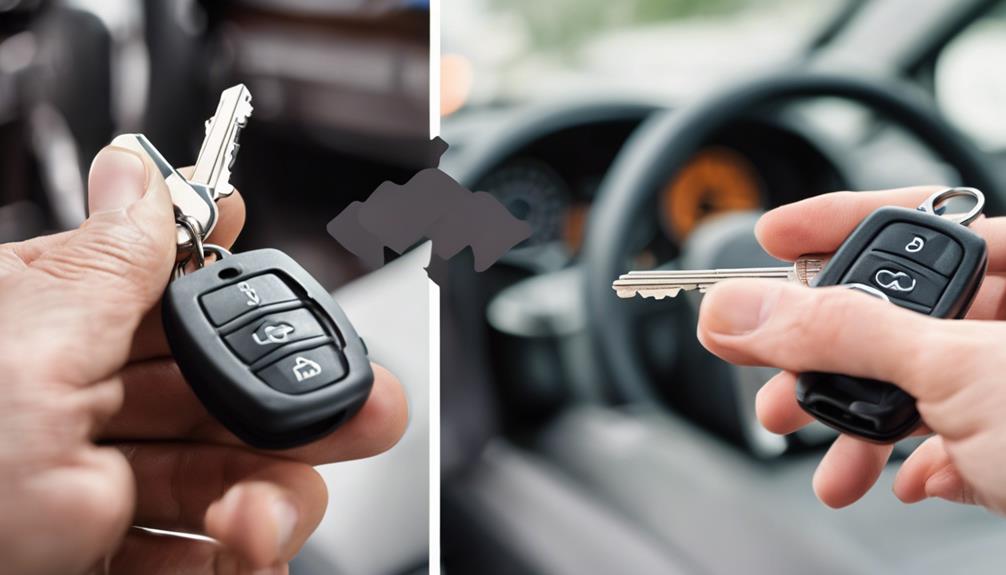
Before you replace your key fob, it's crucial to verify its compatibility with your vehicle. Start by checking your vehicle manual for specific details on the fob type you need. You can also consult the manufacturer's website for the most accurate information to guarantee a proper fit. If you're unsure about compatibility, a professional locksmith can also help guide you in finding the right key fob for your vehicle.
Check Vehicle Manual
A key fob is an important tool for accessing your vehicle, but compatibility issues can arise. To guarantee your key fob works seamlessly, you should consult your vehicle manual. This resource is crucial for effective key fob troubleshooting and maintenance. Here's what to look for:
- Fob Specifications: Check the model number and frequency to confirm compatibility. If you're unsure about your key fob's specifications, refer to resources like Unlocking Key Fobs: Tools and Techniques for Locksmiths for guidance.
- Programming Instructions: Understand the steps required to program a new fob if needed.
- Battery Type: Identify the battery specifications for proper key fob maintenance.
Consult Manufacturer Website
After checking your vehicle manual, the next step is to consult the manufacturer's website to verify your key fob's compatibility. This is essential for effective key fob troubleshooting. You'll find detailed information regarding which fobs work with your specific model, including any updates or recalls that might affect remote entry issues. If your fob isn't listed, it might be time to think about a replacement. Manufacturers often provide guidance on purchasing the correct fob, ensuring you avoid any compatibility headaches. Additionally, you might discover useful FAQs or forums that address common concerns and solutions, such as whether locksmiths can program key fobs for multiple vehicles. Taking this step empowers you to tackle any fob-related problem confidently, putting you back in control of your vehicle's access.
Seek Professional Help
When your key fob stops working, seeking professional help can be your best option. Instead of struggling with key fob troubleshooting on your own, consider leveraging expert skills. Here's what you should do:
- Contact a Professional Locksmith: They specialize in key fob issues and can quickly diagnose the problem. Locksmiths can also program transponder keys without the original, which is a valuable service according to industry standards.
- Request Key Fob Programming: If your fob needs reprogramming, a locksmith has the tools and knowledge to handle it efficiently.
- Inquire About Replacement Solutions: If your fob is lost or stolen, they can guide you through secure replacement options.
Choosing professional locksmith services not only saves you time but guarantees your vehicle's security is uncompromised. Don't hesitate; empower yourself by reaching out for expert assistance.
Replace the Key Fob
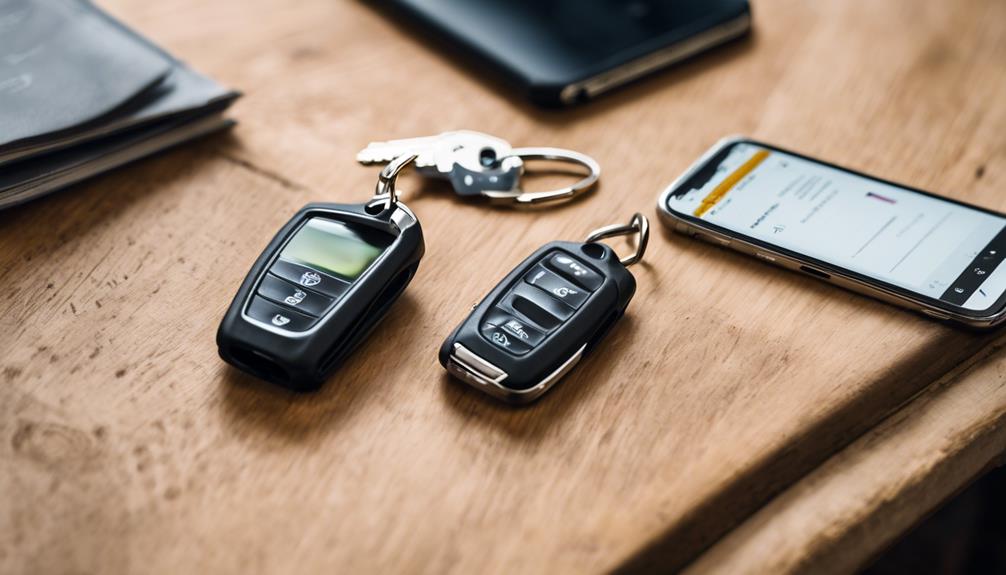
If your key fob stops working, replacing it is often the best option. You'll need to purchase a new fob and program it to match your vehicle. Be sure to evaluate the costs and available options to find the best fit for your needs.
Purchase a New Fob
Replacing a key fob can seem intimidating, but it's often a straightforward process. First, you need to identify the fob types compatible with your vehicle. Manufacturers often provide guidelines for this. Next, consider your options:
- OEM Fobs – Original Equipment Manufacturer options guarantee perfect fit and functionality.
- Aftermarket Options – These can be more affordable and may offer additional features.
- Used Fobs – A cost-effective choice, but confirm they're in good condition.
Once you've selected your preferred option, purchase it from a reliable source. Keep in mind that the quality of your new fob greatly impacts your vehicle's security and functionality. Don't rush; choose wisely to regain that control and convenience you deserve.
Program the Replacement Fob
Your new key fob needs to be programmed to sync with your vehicle's system before it can be used. Start by consulting your vehicle's manual for specific programming instructions, as these can vary by make and model. Most modern fobs offer advanced features like remote start and keyless entry, enhancing your driving experience. For seamless integration, follow the step-by-step process carefully. If you encounter issues, don't panic; use fob troubleshooting tips like checking the battery or ensuring you're within range of the vehicle. Once programmed, test all key fob features to confirm everything's functioning correctly. A properly synced key fob not only provides convenience but also reinforces your control over your vehicle.
Cost Considerations and Options
After successfully programming your new key fob, it's important to take into account the costs associated with replacing it if necessary. Fob technology can be expensive, so knowing your options can save you money and stress. Here are three replacement options to contemplate:
- Dealer Replacement: Often the most costly, dealerships provide OEM fobs that guarantee compatibility.
- Aftermarket Fobs: These can be more affordable and offer similar functionality, but verify they meet your vehicle's specifications.
- DIY Programming Kits: For the tech-savvy, these kits can save you bucks, but require some effort.
Understanding these replacement options empowers you to make a savvy choice, making sure you're never left without access to your vehicle.
Prevent Future Issues
To prevent future issues with your key fob, it's essential to take a few proactive measures. First, prioritize regular key fob maintenance. Keep it clean and replace the battery as needed to guarantee peak functionality. Store your fob in a safe, designated spot to minimize the risk of loss or theft. Implement strong security practices by avoiding leaving your key fob in plain sight inside your vehicle or near your home. Consider investing in a signal-blocking pouch to thwart potential hacking attempts. Finally, familiarize yourself with your vehicle's security features to better protect against unauthorized access. By taking these steps, you'll not only enhance your key fob's longevity but also bolster your overall security.


